Preparing the floor for laying linoleum: rules for working with various substrates
Linoleum is a floor covering used worldwide with success for more than a hundred years. It has a lot of indisputable advantages: simplicity of flooring, wear resistance, hygiene, unpretentiousness in leaving and, what is also important, reasonable price. Using linoleum, you can easily imitate any type of coating - the range of colors, patterns and patterns of the material is so rich. Working with canvases is always easy and pleasant - even for a novice who only masters the basics of repair wisdom. All this allows you to lay linoleum in almost any room: in the bedroom, in the kitchen, in the hallway, in the office. However, you should not go to extremes, considering linoleum material, which is straightforward to "do nothing." This coating is quite elastic - even the smallest errors of the base can adversely affect its appearance and significantly reduce the lifetime. Therefore, it is very important to prepare the floor for laying linoleum qualitatively. This is one of the key success factors for the entire process.
As a rule, almost all the problems that have to be encountered during the laying and operation of many coatings, and in particular linoleum, are associated with errors in the construction of the base. In order for the floor material to serve for a long time and please with its aesthetics, the base should be:
- durable;
- dry
- monolithic;
- smooth (no more than 2 millimeters at a base of 2 meters).
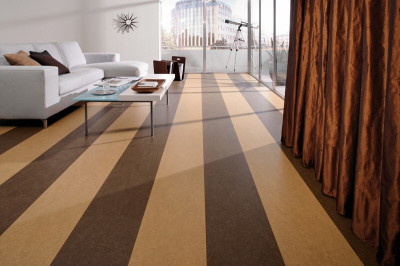
In general, linoleum is allowed to be laid on almost any surface (the main thing is that its “condition" corresponds to all requirements): ready-made concrete slab; screed; wooden floor; base made of particleboard, gypsum fiberboard, MDF or moisture-proof plywood; ceramic tiles or linoleum in good condition.
Floor preparation for linoleum can be done in various ways - it all depends on the "source data" in the room, the financial and temporary capabilities of the owners, etc. To say that some reason is worse, and some better is definitely impossible - each case is individual. It is not at all necessary to tear off the wooden floor and make a screed under linoleum just because the neighbor did it. If the apartment already has a certain floor covering, you need to build on this.
Content
Concrete surface preparation
A completely flat concrete floor slab is, of course, a rare but not exceptional case. If the area of the room "fits" into the framework of one slab and the level of horizontalness of the latter is satisfactory, you can limit yourself to a number of simple preparatory operations. First of all, the stove needs to be cleaned of dust and dirt. Then apply dispersion putty on its entire surface - using a flat spatula, using a “scratching” method. The composition will fill all the chips, shells and other bumps. As a result, you get a perfectly flat base. If necessary, the surface after the polymerization of the putty can be sanded.This is one of the easiest and most economical ways to prepare the floor for laying linoleum, if you start the repair, as they say, “from scratch”.
Topic article: Laying linoleum on a concrete floor - methods and subtleties of technology
Self-leveling screed device
To quickly create a high-quality, durable, monolithic base for linoleum, often use self-leveling mixtures. They are easy to use and after drying do not require any additional processing.
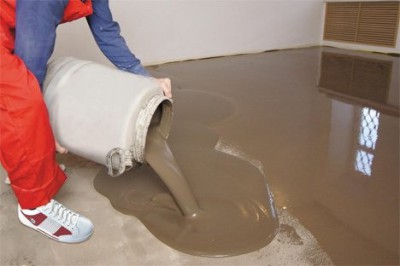
When choosing this method, proceed as follows:
- Seal large openings and recesses in the concrete surface with a quick-hardening filling mass for rough leveling of the substrates.
- Prime the surface with a roller in two or three layers (mutually perpendicular).
- Prepare a self-leveling mass according to the manufacturer's instructions. Mixing the mixture should be thorough, but not long. As a result, you will get a homogeneous mass that has the consistency of batter. Hold a pause of 2-3 minutes, necessary for a series of chemical reactions in the solution, and mix it again.
- Pour the composition onto the primed surface and evenly distribute it with a squeegee - notched trowel.
- Walk along the needle roller formed by the layer - this will help to completely remove air bubbles from it.
- Wait until the mixture crystallizes completely (usually enough days) and you can safely proceed to further work on laying linoleum.
Wood flooring
A wooden floor is also a good option for a linoleum base. Is it difficult to prepare it? It all depends on the state in which it is currently. First of all, the wooden floor should be inspected for mold; if there is one, it is better to pluck the boards and think about the screed device. If no areas affected by the fungus are found, it is necessary to check whether all the elements are well fixed, and if necessary, strengthen the structure. All protruding hats of nails, self-tapping screws, etc. must be eliminated. Individual bulges of the material itself can be removed with a plane. Slots should be putty, and after drying, grind.
If the floor is very uneven, with many large flaws, the only right solution is to lay plywood on it, and only then proceed with the installation of the finish coating.
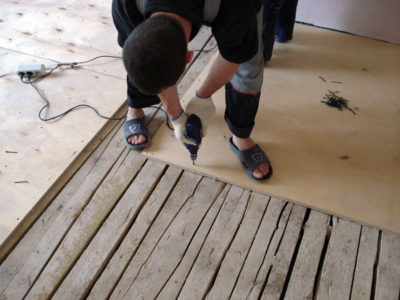
Topic article: Laying linoleum on a wooden floor - the nuances of work
Old linoleum - leave or not?
Are the floors in your house covered with old linoleum? Do not rush to pluck it. After all, this material can be an excellent substrate for new paintings. True, only if it is firmly held, does not have deformations, bumps, torn sections and other defects. Everything is fine? So, you can start laying new coatings. Before starting work, thoroughly clean and degrease the surface, and feel free to get down to business.
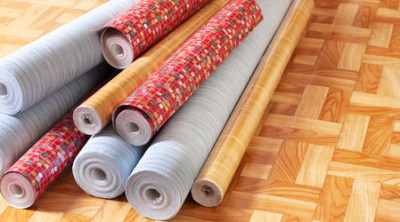
Topic article: Is it possible to put linoleum on linoleum - we solve the dilemma
Ceramic tile - a reliable option
You can prepare it this way:
- check the surface for chips and cracks;
- close small flaws with epoxy;
- remove the cracked elements, and align these places with tile glue;
- After drying, sand the entire surface and rinse thoroughly.
Tile to leave as the basis for linoleum is not only possible, but also necessary.
GVL base unit
Prefabricated floors from GVL - a reliable, practical and easy to install system that allows you to form a perfectly flat base for linoleum, as well as increase the heat and sound insulation in the house.
The technology of laying the foundation of the GVL:
- lay a plastic film on a clean carrier base;
- along the perimeter of the room lay a tape made of foamed polyethylene;
- set the beacons on the level; fall asleep and stretch the backfill. It is optimal to use expanded clay sand as a backfill. The minimum layer is 20 millimeters;
- proceed with laying the two-layer GVL. Laying should be carried out from the doorway to the opposite wall - in this way it will be possible to maintain the surface of the backfill;
- for elements “in contact” with the walls, the folds in the mating area must be cut off. To eliminate waste and ensure the displacement of the butt joints in adjacent rows, each new row should begin with a piece remaining from the last element of the previous row;
- as you lay sheets on the folds, apply PVA on a gypsum base and do not forget to fasten the structure with special screws.
That's all. Now you know how to prepare the floor for linoleum correctly, what methods exist for this and what you need to pay attention to during the work.

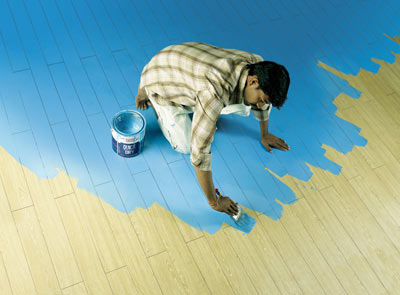


4 comments